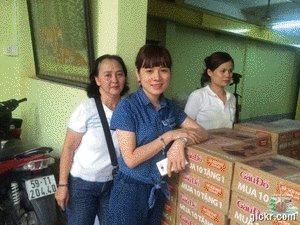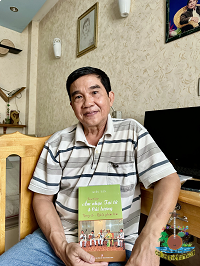•Menu
•Tin đọc nhiều
-
 NSND
Thanh
Nam
và
nghệ
sĩ
Chí
Tâm
ngồi
ghế
nóng
"Chuông
vàng
vọng
cổ"
lần
thứ
19
-
2024
NSND
Thanh
Nam
và
nghệ
sĩ
Chí
Tâm
ngồi
ghế
nóng
"Chuông
vàng
vọng
cổ"
lần
thứ
19
-
2024 -
 Tâm
Sự
Thần
Y
4.0
Tâm
Sự
Thần
Y
4.0 -
 Thông
diệp
của
cải
lương
điện
ảnh
Thông
diệp
của
cải
lương
điện
ảnh -
 Nhiều
người
trẻ
tâm
huyết
với
nghệ
thuật
hát
bội
Nhiều
người
trẻ
tâm
huyết
với
nghệ
thuật
hát
bội -
 “Đêm
huyền
thoại”
quy
tụ
nhiều
ngôi
sao
sân
khấu
cải
lương
“Đêm
huyền
thoại”
quy
tụ
nhiều
ngôi
sao
sân
khấu
cải
lương -
 Thí
sinh
Lê
Hoàng
Nghi
đoạt
giải
Chuông
vàng
vọng
cổ
lần
thứ
19
–
năm
2024
Thí
sinh
Lê
Hoàng
Nghi
đoạt
giải
Chuông
vàng
vọng
cổ
lần
thứ
19
–
năm
2024 - Giữ bản sắc cho cải lương tuồng cổ
-
 CAILUONGVIETNAM.COM
13/04/2004
-
13/04/2025
CAILUONGVIETNAM.COM
13/04/2004
-
13/04/2025
•Tin ngẫu nhiên
-
 Nữ
nghệ
sĩ
Ngọc
Đáng
Nữ
nghệ
sĩ
Ngọc
Đáng -
 LY
RƯỢU
MỪNG
-
tg
Phạm
Văn
Đằng
LY
RƯỢU
MỪNG
-
tg
Phạm
Văn
Đằng -
 Nhạc
sĩ
Hoàng
Việt:
Khi
ra
đi
có
hứa
thu
nay
về...
Nhạc
sĩ
Hoàng
Việt:
Khi
ra
đi
có
hứa
thu
nay
về... -
 Ngọc
Huyền
xúc
động
trong
chương
trình
vinh
danh
nhạc
sĩ
Bắc
Sơn
Ngọc
Huyền
xúc
động
trong
chương
trình
vinh
danh
nhạc
sĩ
Bắc
Sơn -
 Tìm
lối
ra
cho
sàn
diễn
cải
lương
Tìm
lối
ra
cho
sàn
diễn
cải
lương -
 Đại
Nghĩa
bị
"Những
người
khốn
khổ"
hành
hạ
Đại
Nghĩa
bị
"Những
người
khốn
khổ"
hành
hạ -
 NSƯT
Quốc
Chiêm:
Nhớ
lại
chèo
thời
hoàng
kim
NSƯT
Quốc
Chiêm:
Nhớ
lại
chèo
thời
hoàng
kim -
 Táo
quân
VTV
diễn
theo
khán
giả
đặt
hàng
Táo
quân
VTV
diễn
theo
khán
giả
đặt
hàng -
 Nghệ
sĩ
Diệu
Hiền,
Ngọc
Hương
khăn
gói
vào
khu
dưỡng
lão
Nghệ
sĩ
Diệu
Hiền,
Ngọc
Hương
khăn
gói
vào
khu
dưỡng
lão -
 Nghệ
sĩ
tài
danh
Đức
Minh
đã
ra
người
thiên
cổ
!
(
1952
-
2014
)
Nghệ
sĩ
tài
danh
Đức
Minh
đã
ra
người
thiên
cổ
!
(
1952
-
2014
)
•Thống kê truy cập
![]() Đang
truy
cập
:
162
Đang
truy
cập
:
162
•Máy chủ tìm kiếm : 9
•Khách viếng thăm : 153
![]() Hôm
nay
:
9949
Hôm
nay
:
9949
![]() Tháng
hiện
tại
:
599384
Tháng
hiện
tại
:
599384
![]() Tổng
lượt
truy
cập
:
100881913
Tổng
lượt
truy
cập
:
100881913
 »
Tin
Tức
»
English
»
Tin
Tức
»
English

CAILUONGVIETNAM.COM 13/04/2004 - 13/04/2025
Sắp tới đây là kỷ niệm 21 năm ngày thành lập trang web cailuongvietnam.com (13/04/2004 - 13/04/2025) Dây là trang tin tức đầu tiên của cailuongvietnam.com từ năm 2004. Còn đuọc gọi là CLVNCOM1 . Thân mời các dộc giả xem những bằi mới hơn tại trang tin tưc CLVNCOM2 theo link dưới dây https://www.cailuongvietnam.com/newscl
Op-Ed: The greatest Mother’s Day gift
Đăng lúc: Thứ bảy - 10/05/2014 10:24 - Đã xem: 4171
Op-Ed: The greatest Mother’s Day gift
As a child growing up, I remember my mother saving the best cuts at dinner for me, making sure my clothes were ironed, that I had books for school and saw a doctor every time I ran a temperature. At that tender age, I already knew that all a mother ever wants is for her children to be healthy, develop well and thrive when they grow up.

Filipino mothers tuck their babies on their chests at a ward of state-owned Fabella maternity hospital in Manila.
Nguồn tin: TNN
Những tin mới hơn
- Actress UT BACH LAN – An Artist’s Life is Like a Short-lived Flower (11/06/2014)
- Vọng Cổ : Sáu Câu (Six Phrases) (18/06/2014)
- Actor Viet Hung (28/06/2014)
- Sixty Zitherists perform in HCMC (03/07/2014)
- Bach Tuyet, A Precious Gem of Cai luong (06/06/2014)
- HISTORY OF VIETNAMESE MUSIC (03/06/2014)
- Ex-ethnic beauty queen says victory made her miserable (25/05/2014)
- Vietnam has full Vietnam has full foundation on sovereignty over Hoang Sa, Truong Sa (27/05/2014)
- Cai luong legend comes to life in photos (29/05/2014)
- Vietnam provinces pledge support foreign investors after riots (18/05/2014)
Những tin cũ hơn
- Traditional Vietnamese music festival kicks off in Bac Lieu (23/04/2014)
- Sad life stories of “Đờn ca tài tử” elite stars (01/04/2014)
- Remembering a hick (hai lua) named Sen (26/03/2014)
- MÁU NHUỘM SÂN CHÙA - YÊN LANG (18/03/2014)
- Ha Long Carnival to take place on April 30 (14/03/2014)
- THE ORIGIN OF THE VONG CO SONG SẦU VƯƠNG Ý NHẠC (07/03/2014)
- Vietnamese artists scoop int’l photo prizes/ City to host first Ao Dai Festival (28/02/2014)
- Don Ca Tai Tu Nam Bo receives UNESCO Award (14/02/2014)
- Opens Restaurant on Dien Bien Phu Street, HCMC (10/02/2014)
- Lunar New Year – a summary of the biggest traditional holiday in Vietnam (01/02/2014)
Mã
an
toàn:
![]()
•CHUYỂN ĐẾN WEBSITE...
•Tin mới nhất
-
 CAILUONGVIETNAM.COM
13/04/2004
-
13/04/2025
CAILUONGVIETNAM.COM
13/04/2004
-
13/04/2025 -
 Thí
sinh
Lê
Hoàng
Nghi
đoạt
giải
Chuông
vàng
vọng
cổ
lần
thứ
19
–
năm
2024
Thí
sinh
Lê
Hoàng
Nghi
đoạt
giải
Chuông
vàng
vọng
cổ
lần
thứ
19
–
năm
2024 - Giữ bản sắc cho cải lương tuồng cổ
-
 “Đêm
huyền
thoại”
quy
tụ
nhiều
ngôi
sao
sân
khấu
cải
lương
“Đêm
huyền
thoại”
quy
tụ
nhiều
ngôi
sao
sân
khấu
cải
lương -
 Tâm
Sự
Thần
Y
4.0
Tâm
Sự
Thần
Y
4.0 -
 Thông
diệp
của
cải
lương
điện
ảnh
Thông
diệp
của
cải
lương
điện
ảnh -
 NSND
Thanh
Nam
và
nghệ
sĩ
Chí
Tâm
ngồi
ghế
nóng
"Chuông
vàng
vọng
cổ"
lần
thứ
19
-
2024
NSND
Thanh
Nam
và
nghệ
sĩ
Chí
Tâm
ngồi
ghế
nóng
"Chuông
vàng
vọng
cổ"
lần
thứ
19
-
2024 -
 Nhiều
người
trẻ
tâm
huyết
với
nghệ
thuật
hát
bội
Nhiều
người
trẻ
tâm
huyết
với
nghệ
thuật
hát
bội -
 Nghệ
sĩ
Bích
Thuận
qua
đời
Nghệ
sĩ
Bích
Thuận
qua
đời -
 Vở
"Sấm
vang
dòng
Như
Nguyệt"
-
dấu
ấn
mới
của
NSƯT
Chí
Linh,
Vân
Hà
Vở
"Sấm
vang
dòng
Như
Nguyệt"
-
dấu
ấn
mới
của
NSƯT
Chí
Linh,
Vân
Hà
•Đăng nhập thành viên
- Những Vở Diễn Hay KIỆT TÁC SÂN KHẤU THẾ GIỚI: LÔI VŨ
- Nghệ Sĩ Tâm Sự Ngọc Huyền 'vẫn bị cấm hát tại Việt Nam'
- Đời Thường Nghệ Sĩ Con dâu trẻ của NSUT Thoại Miêu qua đời chưa đầy 2 năm cưới
- Đời Thường Nghệ Sĩ Nghệ sĩ Tú Sương kết hôn với Việt kiều
- Tâm Tư Thành Viên Người trong giới tự nói gì về nghệ sĩ Mỹ Châu ?
- Trong bầu trời nghệ thuật sân khấu cải lương, nghệ sĩ Thành Được mãi là ngôi sao sáng vĩ đại. Ông đã...
- Tôi cũng biết một soạn giả có tên YÊN BA, nhưng tên thật là PHẠM DIỆP PHƯƠNG, là quân y, KBC 7019
- Bài viết khá đầy đủ về cuộc đời của thầy Văn Hải. Có vài lỗi chính tả không nên có
- thag điên nai ma diên cai gi . toan bac chuoc nsut thanh nam . bat chuoc kieu ngu
- Tôi rất mong chờ để được xem cải lương nhưng thật thất vọng.

CAILUONGVIETNAM.COM 13/04/2004 - 13/04/2025
Sắp tới đây là kỷ niệm 21 năm ngày thành lập trang web cailuongvietnam.com (13/04/2004 - 13/04/2025) Dây là trang tin tức đầu tiên của cailuongvietnam.com từ năm 2004. Còn đuọc gọi là CLVNCOM1 . Thân mời các dộc giả xem những bằi mới hơn tại trang tin tưc CLVNCOM2 theo link dưới dây https://www.cailuongvietnam.com/newscl






































Ý kiến bạn đọc